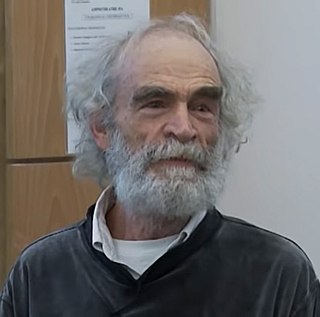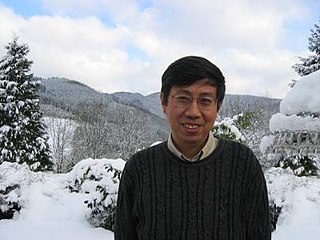Related Research Articles

In mathematics, complex geometry is the study of geometric structures and constructions arising out of, or described by, the complex numbers. In particular, complex geometry is concerned with the study of spaces such as complex manifolds and complex algebraic varieties, functions of several complex variables, and holomorphic constructions such as holomorphic vector bundles and coherent sheaves. Application of transcendental methods to algebraic geometry falls in this category, together with more geometric aspects of complex analysis.

Riemannian geometry is the branch of differential geometry that studies Riemannian manifolds, defined as smooth manifolds with a Riemannian metric. This gives, in particular, local notions of angle, length of curves, surface area and volume. From those, some other global quantities can be derived by integrating local contributions.

Symplectic geometry is a branch of differential geometry and differential topology that studies symplectic manifolds; that is, differentiable manifolds equipped with a closed, nondegenerate 2-form. Symplectic geometry has its origins in the Hamiltonian formulation of classical mechanics where the phase space of certain classical systems takes on the structure of a symplectic manifold.
In mathematics, a symplectomorphism or symplectic map is an isomorphism in the category of symplectic manifolds. In classical mechanics, a symplectomorphism represents a transformation of phase space that is volume-preserving and preserves the symplectic structure of phase space, and is called a canonical transformation.

Mikhael Leonidovich Gromov is a Russian-French mathematician known for his work in geometry, analysis and group theory. He is a permanent member of Institut des Hautes Études Scientifiques in France and a professor of mathematics at New York University.
In mathematics, specifically in topology and geometry, a pseudoholomorphic curve is a smooth map from a Riemann surface into an almost complex manifold that satisfies the Cauchy–Riemann equation. Introduced in 1985 by Mikhail Gromov, pseudoholomorphic curves have since revolutionized the study of symplectic manifolds. In particular, they lead to the Gromov–Witten invariants and Floer homology, and play a prominent role in string theory.
In mathematics, specifically in symplectic topology and algebraic geometry, one can construct the moduli space of stable maps, satisfying specified conditions, from Riemann surfaces into a given symplectic manifold. This moduli space is the essence of the Gromov–Witten invariants, which find application in enumerative geometry and type IIA string theory. The idea of stable map was proposed by Maxim Kontsevich around 1992 and published in Kontsevich (1995).
In mathematics, specifically in symplectic topology and algebraic geometry, Gromov–Witten (GW) invariants are rational numbers that, in certain situations, count pseudoholomorphic curves meeting prescribed conditions in a given symplectic manifold. The GW invariants may be packaged as a homology or cohomology class in an appropriate space, or as the deformed cup product of quantum cohomology. These invariants have been used to distinguish symplectic manifolds that were previously indistinguishable. They also play a crucial role in closed type IIA string theory. They are named after Mikhail Gromov and Edward Witten.
In mathematics, Floer homology is a tool for studying symplectic geometry and low-dimensional topology. Floer homology is a novel invariant that arises as an infinite-dimensional analogue of finite-dimensional Morse homology. Andreas Floer introduced the first version of Floer homology, now called Lagrangian Floer homology, in his proof of the Arnold conjecture in symplectic geometry. Floer also developed a closely related theory for Lagrangian submanifolds of a symplectic manifold. A third construction, also due to Floer, associates homology groups to closed three-dimensional manifolds using the Yang–Mills functional. These constructions and their descendants play a fundamental role in current investigations into the topology of symplectic and contact manifolds as well as (smooth) three- and four-dimensional manifolds.
In mathematics, the Gromov invariant of Clifford Taubes counts embedded pseudoholomorphic curves in a symplectic 4-manifold, where the curves are holomorphic with respect to an auxiliary compatible almost complex structure.
In mathematics, the Weinstein conjecture refers to a general existence problem for periodic orbits of Hamiltonian or Reeb vector flows. More specifically, the conjecture claims that on a compact contact manifold, its Reeb vector field should carry at least one periodic orbit.
In mathematics, specifically in symplectic geometry, the symplectic sum is a geometric modification on symplectic manifolds, which glues two given manifolds into a single new one. It is a symplectic version of connected summation along a submanifold, often called a fiber sum.

Tian Gang is a Chinese mathematician. He is a professor of mathematics at Peking University and Higgins Professor Emeritus at Princeton University. He is known for contributions to the mathematical fields of Kähler geometry, Gromov-Witten theory, and geometric analysis.

Clifford Henry Taubes is the William Petschek Professor of Mathematics at Harvard University and works in gauge field theory, differential geometry, and low-dimensional topology. His brother is the journalist Gary Taubes.
The Oswald Veblen Prize in Geometry is an award granted by the American Mathematical Society for notable research in geometry or topology. It was funded in 1961 in memory of Oswald Veblen and first issued in 1964. The Veblen Prize is now worth US$5000, and is awarded every three years.
In mathematics, specifically in symplectic topology and algebraic geometry, a quantum cohomology ring is an extension of the ordinary cohomology ring of a closed symplectic manifold. It comes in two versions, called small and big; in general, the latter is more complicated and contains more information than the former. In each, the choice of coefficient ring significantly affects its structure, as well.
The Geometry Festival is an annual mathematics conference held in the United States.
In geometry and topology, trivial cylinders are certain pseudoholomorphic curves appearing in certain cylindrical manifolds.
In mathematics, especially in topology, a Kuranishi structure is a smooth analogue of scheme structure. If a topological space is endowed with a Kuranishi structure, then locally it can be identified with the zero set of a smooth map , or the quotient of such a zero set by a finite group. Kuranishi structures were introduced by Japanese mathematicians Kenji Fukaya and Kaoru Ono in the study of Gromov–Witten invariants and Floer homology in symplectic geometry, and were named after Masatake Kuranishi.
References
- Gromov, M. (1985). "Pseudo holomorphic curves in symplectic manifolds". Inventiones Mathematicae . 82 (2): 307–347. doi:10.1007/BF01388806. S2CID 4983969.
- Bourgeois, F.; Eliashberg, Ya.; Hofer, H.; Wysocki, K.; Zehnder, E. (2003). "Compactness results in symplectic field theory". Geometry and Topology . 7 (2): 799–888. arXiv: math/0308183 . doi:10.2140/gt.2003.7.799. S2CID 11794561.